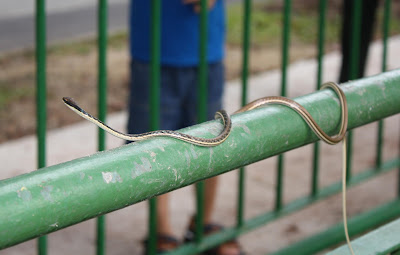So we rushed up the hill, frantically searching, looking around for the snake we were told about. And then, from the corner of my eye, I saw a bright blue stripe. It was a Blue Malayan Coral Snake, a highly venomous front-fanged snake that you definitely wouldn't want to get really close to.
I started photographing the snake right away. It was the first time seeing this snake in the wild, and I didn't want to miss the chance.
This species is supposed to be a nocturnal hunter however. I'm not sure why it was lurking around during the day. But still, this is one snake you don't want to get bitten by, no matter what. I've read that these snakes, despite their highly neurotoxic venom, are unoffensive and gentle creatures that can easily die of fright. I've heard that there is no anti-venom for this species, so if you're bitten, you might just wanna say a final goodbye to all your loved ones. But as long as you don't provoke the snake and keep a good distance, you should be safe.
The snake was trying to get to the other side of the tarred path, so with the help of the reserve officers we helped it move away. Here's a shot of the snake crossing the path. It was definitely at least one and a half metres long.
Here's a shot of the bright, red tail. As you can see, this species has a bright red head and tail, and a bright blue body, which comprises of two different shades. Light blue by the sides and a strip of dark blue in the middle. The underside of the snake is also bright red, like the head and tail.
It slithered down into the undergrowth and vanished soon after.
























































